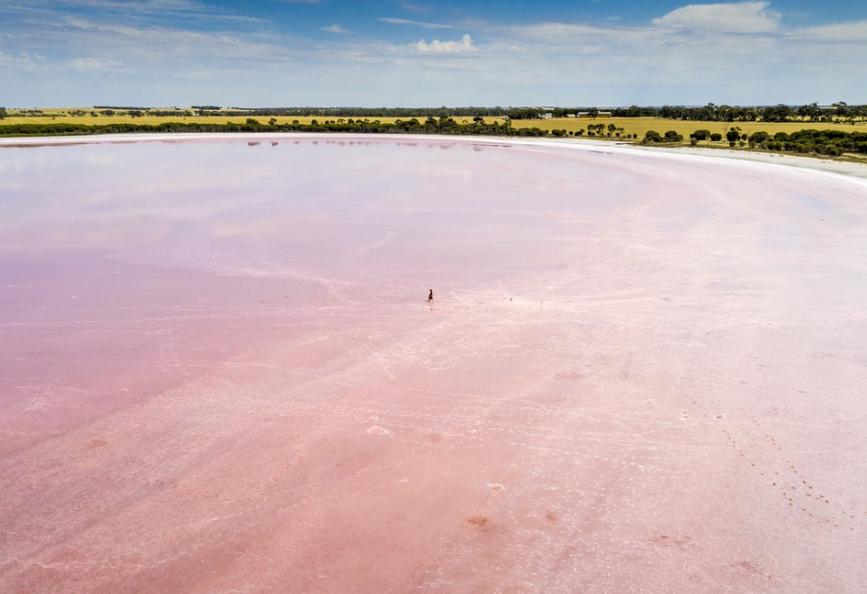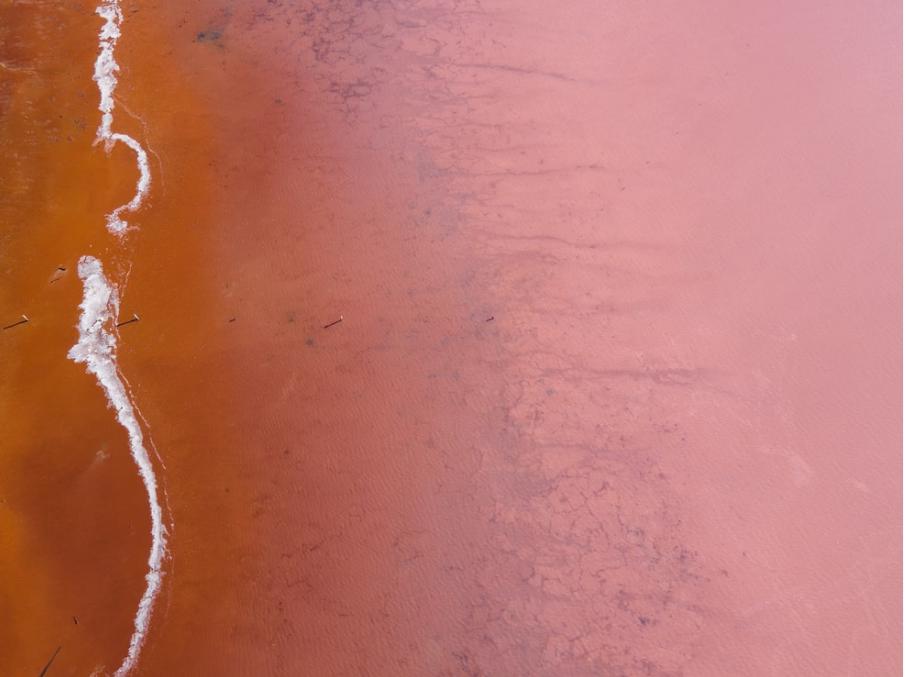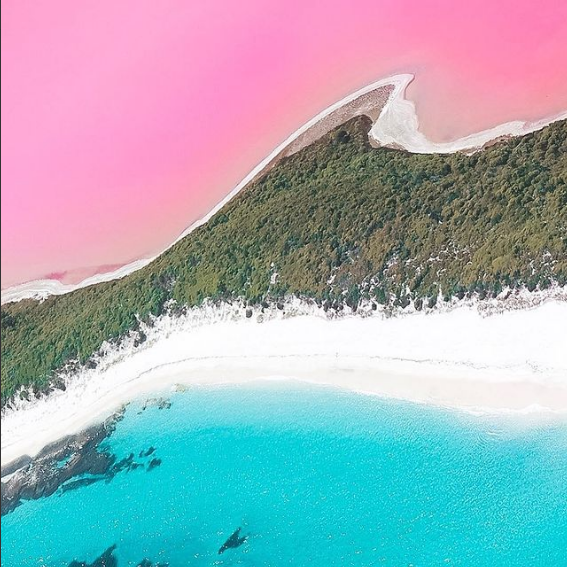Lake Hillier in Australia: Nature never ceases to amaze us. Visualize an eye-catching pink and breathtaking scenery from a sky-high point of view. On Middle Island, the largest of the 105 islands and islets making up the Recherché Archipelago in Western Australia, you will spot a naturally occurring pink lake Hillier, accurately depicting the planet’s vibrant colors and bizarre landscapes.
The small Lake measuring 600 meters (2,000 feet) in length by about 250 m (820 feet) in width is located near the island’s northern shore. It is surrounded by sand and a dense woodland of paperback and eucalyptus trees. Its geographic coordinates are 34°5′45″S 123°12′10″E.
The northern edge is separated from the north of the coast of Middle Island by a narrow strip of dunes covered by vegetation. Its shoreline is also covered in salt crust deposits.
Lake Hillier is home to many birds, both native and migrative birds.
It is A Uniquely Pink Lake
The world has its fair share of pink lakes that sum up to 29, with Australia bagging over ten, namely, Lake Hillier, Pink Lake & Lake Warden, Hutt Lagoon, Quairading Pink Lake, Lake Eyre, Lake Bumbunga, Westgate Lake, LAKE MACDONNELL, and many others.

While other pink lakes around the globe regularly change color due to temperature fluctuations, Lake Hillier maintains its pink color year-round making it unique.
You can see this distinct pink color while closer to the Lake, or if you are watching it from above, the contrast between the gorgeous pink of the Lake and the blue color of the Pacific Ocean lying next to it is striking.
Interestingly, the water remains pink even when removed from the Lake and bottled, unlike other pink lakes.
The Discovery of Lake Hillier in Australia
Lake Hillier was initially discovered in 1802 by European Navigator and Cartographer Mathew Flinders, who led the first inshore circumnavigation of the landmass known as Australia. After he landed ashore, he found the Lake and climbed the highest peak on the island, named after him today; Flinders Peak.

He jotted down that he was surprised to see “a small lake of rose color” in his log. The crew brought on board salt from the shores of the Lake, which the log notes that were of good quality and required no other process than drying to be fit for use. Upon investigations, they found that the Lake was as saturated with salt that sufficient quantities were crystallized near the shores to load a ship.
While revisiting the island in 1803, Flinders decided to name the lake ‘Hillier’ after a crew member named William Hillier died of dysentery while the ship they were traveling had docked.
Why is it Pink?-Australia Facts
Most scientists conclude that the bubblegum coloration of the Lake has probably something to do with the presence of a specific species of microalgae – Dunaliella Salina in the Lake.
One study describes Dunaliella Salina as halophilic or salt-loving algae. Halophiles sustain themselves in highly saline environments by the process of osmoregulation, and their enzymes are adapted to functioning at high salt concentrations.
While Lake Hillier is hypersaline and not an easy place for an alga to live, Dunaliella Salina thrives in it. Therefore, she is considered an extremophile (an organism that thrives in environments that most others can’t tolerate) because of her rare ability to survive in salty habitats like this one.
The Extreme Microbiome Project (XMP) in 2016 conducted by the Association of Biomolecular Resource Facilities (ABRF) and Metagenomics Research Group (MGRG) performed a metagenomics analysis on the Lake and found Dunaliella as well as Salinibacter Ruber, Dechloromonas Aromatica, and a few species of the Archaea.
This research shed some light on this mystery surrounding the Lake’s color, attributing it to a range of microbial diversity in the Lake, which indicates that many algal, bacterial and archaeal halophiles contribute to the persistent pigmentation of this bubblegum paradise.
Further Explanation
In other words, these microbes create pigment compounds called carotenoids(which can look pink, red, or orange) to absorb sunlight. These compounds are thought to be the root cause of the algae turning pink.
Bacteria and Archaea make up the bulk of the micro-ecology of hypersaline lakes in the world. Salina is accountable for the otherworldly colors of the purple waters, such as the Dead Sea, where similar algae thrive.
The researchers at XMP were able to trace the roots of Lake Hillier and found that the pink Lake was once used as a leather tanning station in the early 1900s.
Because of its large salt deposits, in 1899, the Lake was used to mine salt. Salt mining is still done at similar famous pink lakes such as Salina de Torrevieja in Spain and Lake Retba in Senegal.

It is no doubt that these brightly pink-hued lakes attract tourists from all over the planet each year, hoping to catch a glimpse of the beauty. So, by the 21st century, The Bay of Isles Esperance, otherwise known as the Recherché Archipelago, became a beloved tourist destination, and tourism is a far more valuable resource for the area.
Can You Swim in Lake Hillier in Australia?
Firstly, the water does not appear to pose any danger to humans. Secondly, Lake Hillier is safe to swim in. However, tourists can’t swim since it now lies within the boundaries of the Recherché Archipelago Nature Reserve, a protected area.
Consequently, since 2002, the Lake itself has been considered a wetland of “subregional significance.”
How Does One Visit Lake Hillier in Australia?
Though it is a small lake, it is not the easiest to get to. There are very few ways to reach Lake Hillier, which are by air and by sea.
Scenic airplane flights are the most common method to fly over Lake Hillier via Cape Le Grand National Park. With an aerial view, one can get the delicate pink bubblegum color.
A cruise boat is the other available option if accompanied by an official guide.
The Bay of Isles provides beautiful sights and sounds. Other activities you can encounter here include:
- Boating
- Birdwatching Native Esperance Birds
- Nature Walks on Woody Island
- Snorkeling
- Fishing


